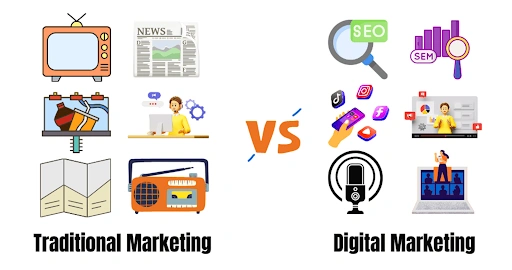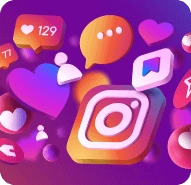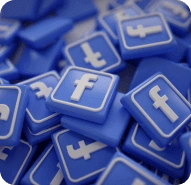Digital marketing learning resources

64
Knowing the difference between digital and traditional marketing is essential for any brand looking to grow. With almost 80% of consumers increasingly conducting product research online before making a purchase, digital marketing—which includes SEO, SEM, and SMM - has gained significant attention in recent years. In contrast, traditional marketing still has significance since it uses offline media, such as billboards, direct mail, and print ads, to reach local audiences.
This guide highlights the specific factors that characterize each approach in a bid to assist you in making a more suitable decision for your brand. We will look at the advantages and disadvantages, the effectiveness of each with respect to ROI, how best to reach out to the consumers, and so forth. You will also learn the factors that impact costs and the reasons why advertisers prefer digital marketing most of the time. When it comes to the final touch, whether it is the need to increase the reach level, raise the level of interaction, or build a properly balanced marketing strategy, one has to focus on both digital marketing and traditional marketing methods, to go for the most optimum one for the enterprise.
Traditional marketing and digital marketing have different approaches to reaching consumers, with different kinds of engagement, and results. To understand what the difference is between digital marketing vs traditional marketing, let's get into their core features and advantages and where they shine best in today's marketing map.
Digital marketing focuses the efforts through social media, search engines, websites, and e-mail to concentrate efforts on targeting customers. This is unique because it can target particular consumer segments with the last word of precision. This enables companies to send messages to users based on criteria such as age, location, or browsing behavior, so campaigns can be very targeted and very efficient. In addition, digital marketing is not costly and highly measurable, bringing real-time performance data through analytics. For instance, if an ad isn't bringing in enough engagement, it can be optimized or even changed immediately without these high costs, unlike traditional marketing. Another striking difference between traditional and online marketing lies in how they interact with audiences:
Digital marketing creates room for both ways of information transference. Users can like, comment, and share content to create direct interactions with the brand and can even influence future campaigns. Traditional marketing, however, remains mostly one-sided as it transmits information without creating an opportunity for live feedback, limiting the mutual engagement process.
Digital marketing content is very wide-ranging such as blogging, producing videos, posting on social media, and podcasting. This contributes to diverse engagements for brands to interact with audiences, creating rich, rich, and interactive experiences. Traditional marketing was usually static content, in the form of print advertisements, billboards, or flyers, and while these may be effective one-off, they often become less dynamic through time.
Understanding the digital marketing and traditional marketing difference helps companies tailor their strategies to specific goals. Traditional marketing works best for generating broad awareness in demographics dominated by offline media. In contrast, digital marketing excels at reaching the right audience with the right message in real-time, offering measurable results. For businesses aiming to maximize both coverage and niche targeting, a hybrid approach combining traditional and digital marketing may be the most effective solution.
Traditional marketing is much more of a challenge in terms of ROI because it is difficult to attribute specific results to individual campaigns. While TV adverts increase the top-of-mind awareness of the brand, it is hard to figure out how many conversions or sales it may lead to. ROI in such cases takes more time and money to be visible.
On the other hand, digital marketing offers metrics that are provided in real-time. This means it is easier to calculate the ROI since from clicks and impressions to conversions and sales, that level of detail is provided on the digital platforms. For example, on a well-optimized PPC advertisement, you can easily see the results right away, thus seeing what is happening as a result of the campaign and changing it for stronger returns.
Traditionally, in terms of ROI, internet marketing gives a faster, measurable return as compared to the traditional one. This advantage of internet compared to traditional media makes it popular with businesses wanting to spend their money as effectively as possible.
The only way that marketing efforts will be effective is by engaging the consumer. Let's look at how engagement differs between traditional marketing and Internet marketing.
Traditional Marketing Engagement Traditional involves in-store promotions and events, which allow more personal interaction with consumers; such experiences are remembered for a long time, causing loyalty to the brand.
Digital marketing engagement: There are a number of digital channels through which consumers can be engaged online-ranging from social media interactions to personalized email marketing. Digital marketing is interactive, and hence brands get the opportunity to respond to consumer reviews in real-time.
Unlike traditional, online marketing differs in the engagement methods. Traditional is a personal connection, but digital utilizes technology to reach consumers on a larger scale, which would often result in an instant response.
Cost constraint is one of the vital differences in choosing between traditional and digital marketing and here is a cost comparison.
Where: Traditional marketing is quite a costlier affair only due to the cost of producing and placing those advertisements in the media. A TV commercial can cost thousands of dollars per minute, which can be too costly for small businesses, etc.
The cost of digital marketing is lesser, and options like social media ads and content marketing can serve the purpose of reaching your target market on a shoestring budget. A study reveals that even small businesses can derive many benefits from digital platforms despite having a small budget.
Digital marketing vs marketing is a cost difference that could make digital strategies relatively easier for startups and small companies to access, but the big corporations will still find the need to use the old ways to establish credibility and brand presence.
A very important reason why someone would opt between these two forms of marketing is audience targeting capability. Here's how targeting differs between these approaches.
Traditional Marketing Targeting: With traditional methods, there is little or no targeting involved; they are mostly based on geographic and demographic factors. For example, a highway advertisement billboard might be viewed by thousands of consumers but it does not target precisely.
Digital Marketing Targeting: With digital marketing, we can deliver our message to an audience with remarkable precision based on demographics, interests, behavior — even location! Such detailed targeting helps marketers be able to reach their target audience effectively for a successful campaign.
One of the main advantages of digital marketing against traditional methods is the capability to pinpoint their target audience more precisely, with conversion rates and ROI becoming significantly better.
The choice between online marketing vs offline marketing is based on a variety of criteria, including corporate goals, budget, and target demographic. Here is a guide on the right approach:
Both of them have their merits in the traditional marketing vs digital marketing debate. Here, a blending of the two- the strands of both traditional and digital marketing benefits a business in reaching every mind and garnering more engagement.
The reach, cost, and adaptability difference between traditional marketing and internet marketing are far-sighted. Traditional marketing might reach a wide audience as compared to digital marketing which can target specific customers and derive measurable outcomes. When comparing these two methods may help you arrive at a conclusion on which works better for your business model.
The discussion of traditional versus digital marketing has been around for a while, with many stating that traditional methods are now much too old-fashioned. That might be a slight exaggeration, but the future of marketing is definitely going to be based on digital advancements. While it is true that digital marketing, when combined with mobile applications has become the core of every modern strategy, revolutionary tools such as augmented reality (AR), artificial intelligence (AI), and machine learning are making an impact on how brands engage with their audience.
In this digital-first world, it becomes imperative for brands to adopt these innovations. Organizations that focus on innovation, customer-centricity, and agility will be better positioned for success. We, at Eduyagna believe that an understanding of both traditional and digital marketing methods can help professionals gain a better grip on the way the industry works.
So, if you wish to upskill, get course digital marketing courses, and equip yourself with the tools of today, Join our course.
Choosing the right digital marketing certification course can be overwhelming, but with so many options available, you're sure to find the perfect fit for your needs and learning style.









Wonderful blog! I found it while surfing around on Yahoo News.
Do you have any tips on how to get listed in Yahoo News?
I've been trying for a while but I never seem to get there!
Thank you http://boyarka-Inform.com/